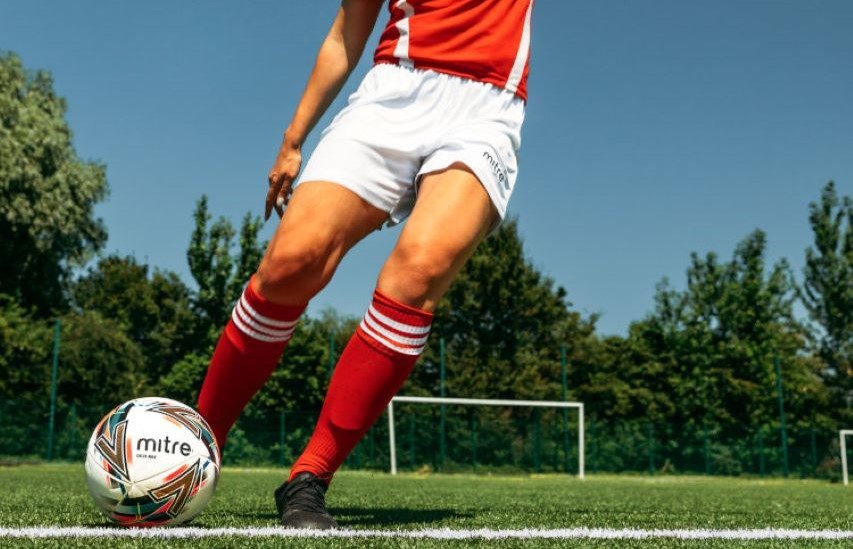The Grassroots Football Guide to Improving Your Weaker Foot

How many times have you watched with frustration as an elite player misses an opportunity or gets a simple on-field action wrong because they were forced to use their weaker foot?
Yes, one-footedness is something that affects top-level players, so it’s not surprising that those much further down the football pyramid suffer from the same deficiency.
The vast majority of people have a strong foot and a weak foot. But with practice, perseverance and the right approach, you can drastically improve the efficacy of your weaker extremity — and enhance your overall game in the process.
And the good news is that those who start the process early enough could develop into a proficient two-footed footballer. Whether you’re a young player or a coach, adopting a few tried-and-tested strategies will maximise your chances of success.
Why the Ability to Use Both Feet Is Important for Grassroots Footballers
One of the keys to persuading grassroots football players to work on their weaker foot is to show them what’s possible when it’s done right.
A Crucial Trait for Well-Rounded Players
Working on the weaker foot is a crucial aspect of developing well-rounded football players.
If you can comfortably switch between both feet without compromising the results you deliver, you can play in more positions, deal with more situations and call upon more choices in the heat of action.
Enhances Versatility and Adaptability
A player with proficiency in both feet gains a tactical advantage, making them versatile and adaptable on the field. A strong weaker foot enables players to navigate various game situations more effectively.
Improves Decision-Making Skills
Training the weaker foot enhances a player's decision-making skills by expanding their options during gameplay. A well-honed weaker foot helps players to make split-second decisions with increased confidence — and more consequential results.
Boosts Overall Performance
Well-rounded players, adept with both feet, contribute significantly to their team's overall performance. They boost their own performances and raise the standards and expectations of teammates.
Key Training Techniques
If you have the right football training equipment, there are lots of drills, techniques and activities you can take on that will improve your weaker foot — and enhance your overall game.
Ball Juggling for Coordination
Incorporate ball juggling exercises to enhance coordination and touch with your weaker foot.
In the beginning, you’ll need to focus fully. One trick involves using the laces of your boot as a market for impact with the ball and your weaker foot.
Passing Drills for Precision
Design passing drills that specifically focus on utilising the weaker foot. Structured passing routines to improve accuracy and control with the non-dominant foot. You can also take every opportunity to practice on your own — at home, on the beach, in the park or anywhere there’s enough space. All you need is a good football and appropriate footwear. Football rebounders are also great for solo passing practice.
Specific Ball Control Exercises
Use targeted ball control exercises to refine touch and control on the weaker foot.
Here at The Soccer Store, we came up with a few practice drills for developing better ball control with your weaker foot.
Consistent Practice
Emphasise the importance of consistent and dedicated practice to see tangible improvements.
Create a training schedule, and make sure there are plenty of activities that allow you to work with your weaker foot.
Create a Routine — And Make Weaker Foot Improvement and Integral Part of It
Consistent and dedicated practice is the cornerstone of developing a proficient weaker foot in football. Improvement comes with regular focused training, commitment and determination.
Players should commit to incorporating weaker foot exercises into their daily or weekly routines, making it an integral part of their overall training regimen. Yes, it’s not particularly exciting — and it can be downright frustrating. However, once you or your players start turning practice into tangible on-pitch improvements, the motivation to keep improving comes naturally.
Create a weekly training schedule that allocates specific time slots for focused sessions. And dedicate sessions for weaker foot drills to ensure players devote ample time and attention to this aspect of their game. By weaving these focused sessions into their weekly training routine, footballers can systematically and progressively improve their weaker foot over time.
Introduce Improvements to Competitive Games
Let’s face it, the whole point of working on your weaker foot is to improve your overall footballing ability and improve your team’s fortunes on the pitch. Once you start noticing improvements, work out how to apply them during matches.
If you’re a coach, you might be able to incorporate the use of the weaker foot strategically during matches. Encourage grassroots footballers to assess game situations and consciously choose the weaker foot when appropriate.
Emphasise decision-making scenarios, such as passing, shooting, or dribbling, where the weaker foot can be effectively utilised to get out of tricky situations or take the opposition by surprise.
Coaches play a crucial role in reinforcing the importance of using the weaker foot during matches. Provide constructive feedback during training sessions and matches, highlighting instances where players successfully apply their weaker foot. Positive reinforcement enhances confidence and motivates players to continue honing their weaker foot skills.
Practice at Every Opportunity
All you need to improve your weak foot is a quality football, the right shoes and the determination to succeed. Of course, you can make things more interesting by investing in a few carefully chosen items of football equipment, including a small portable football goal for the garden or some lightweight football markers for impromptu dribbling drills with your weaker foot.
Make the world your training pitch, and you can become a two-footed player quicker than you probably think.

